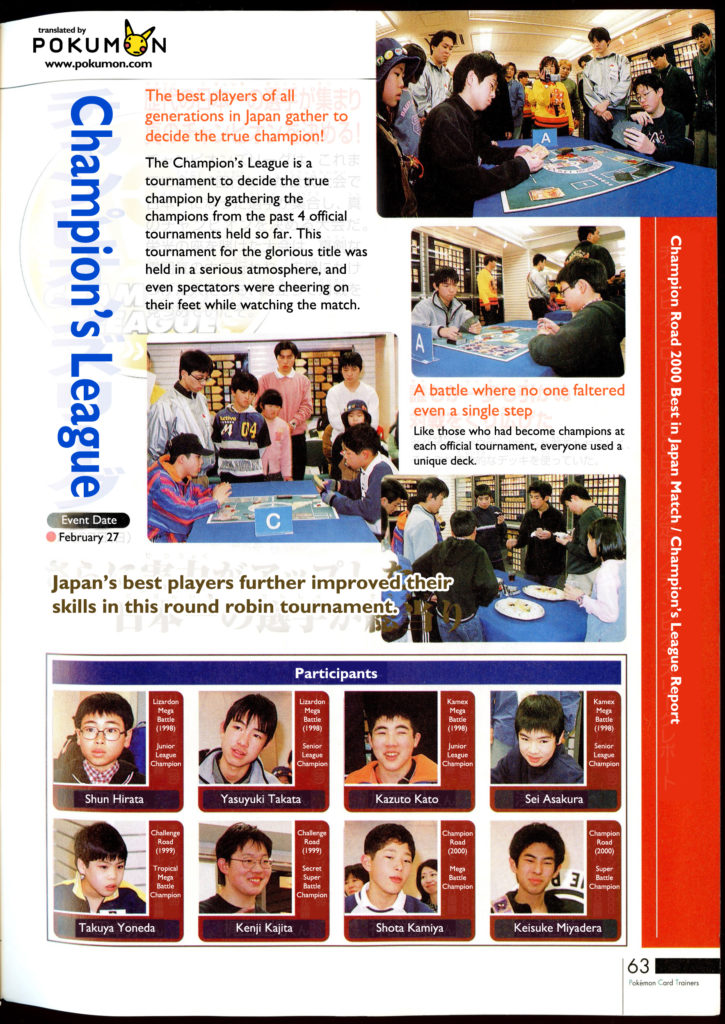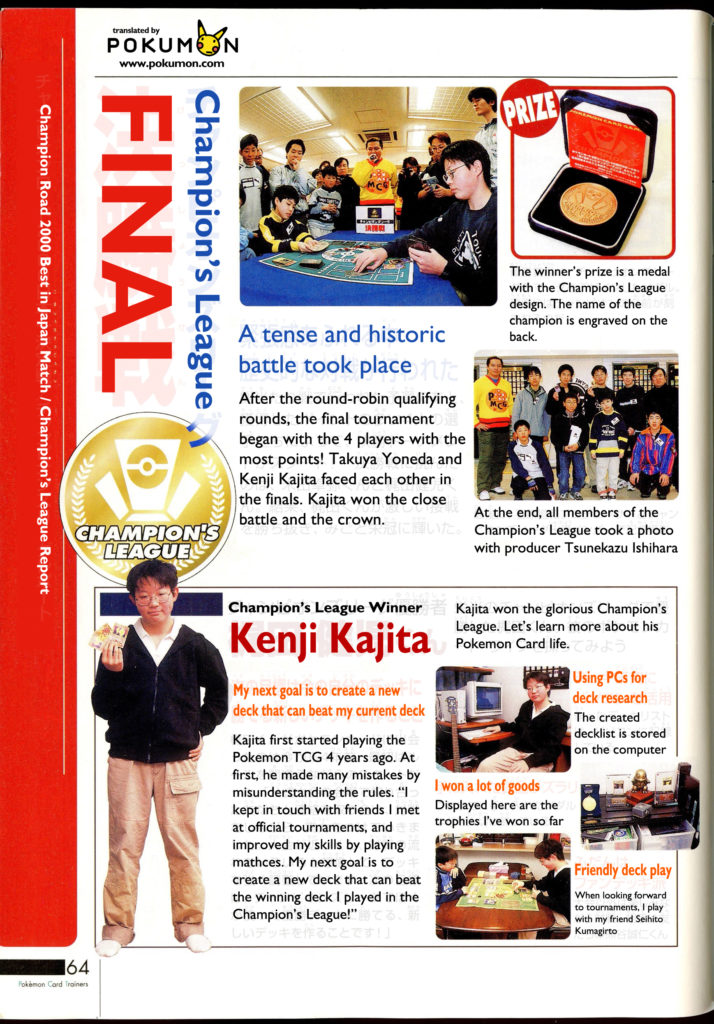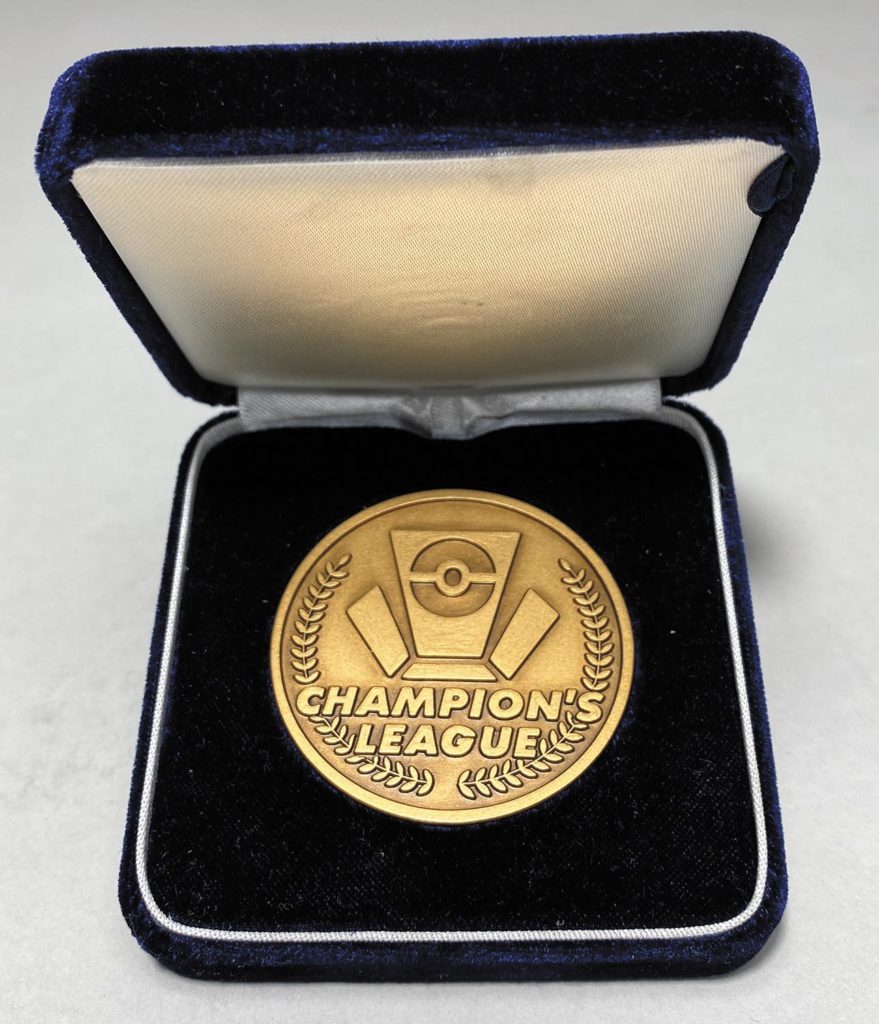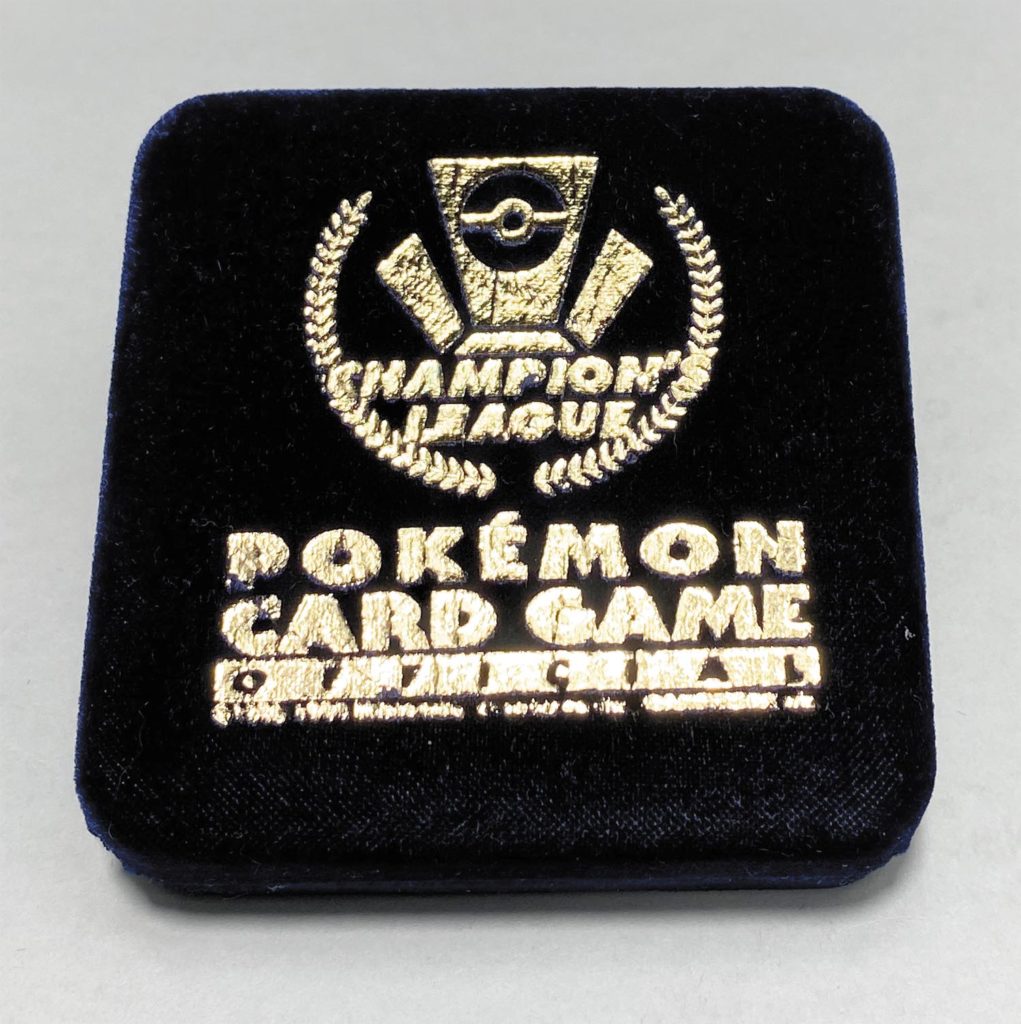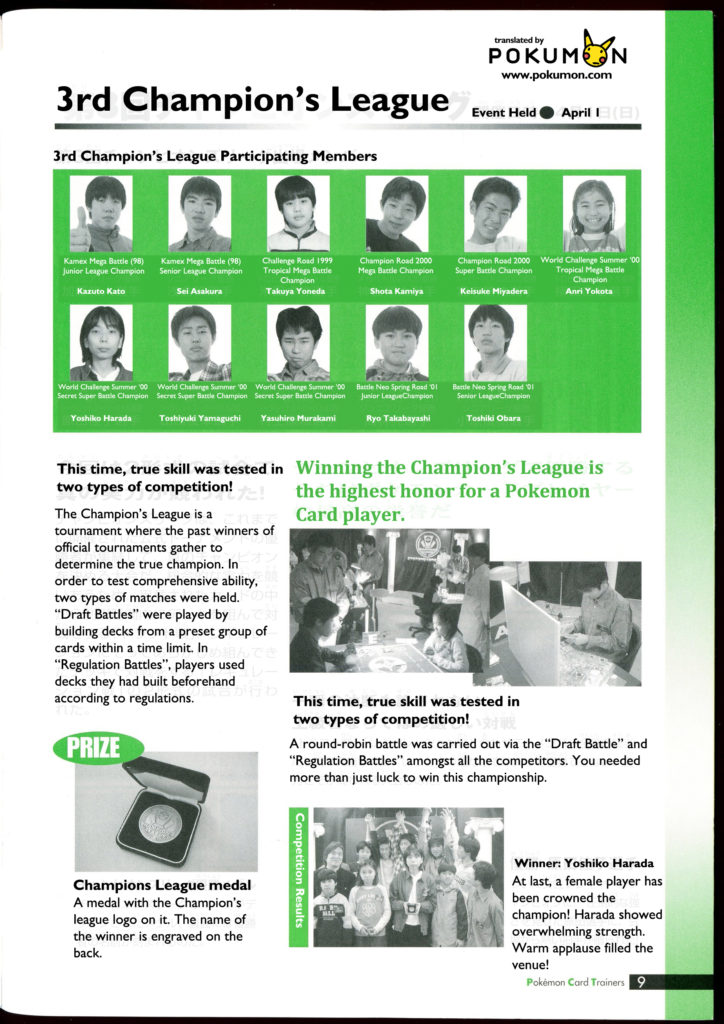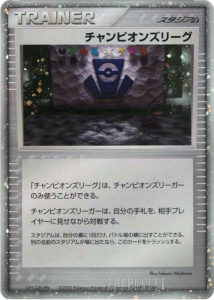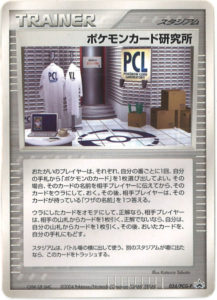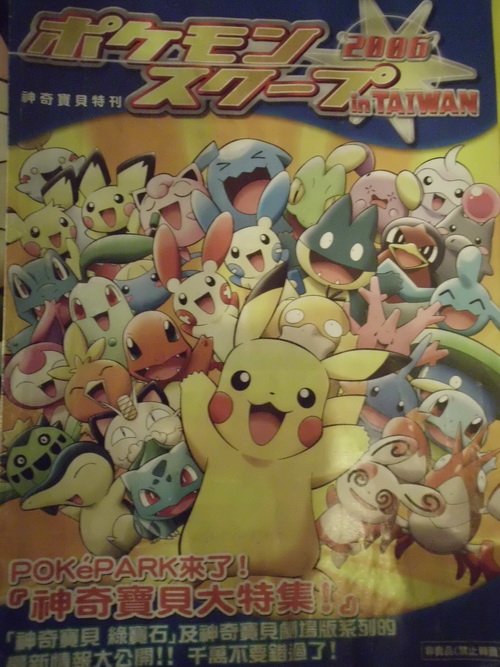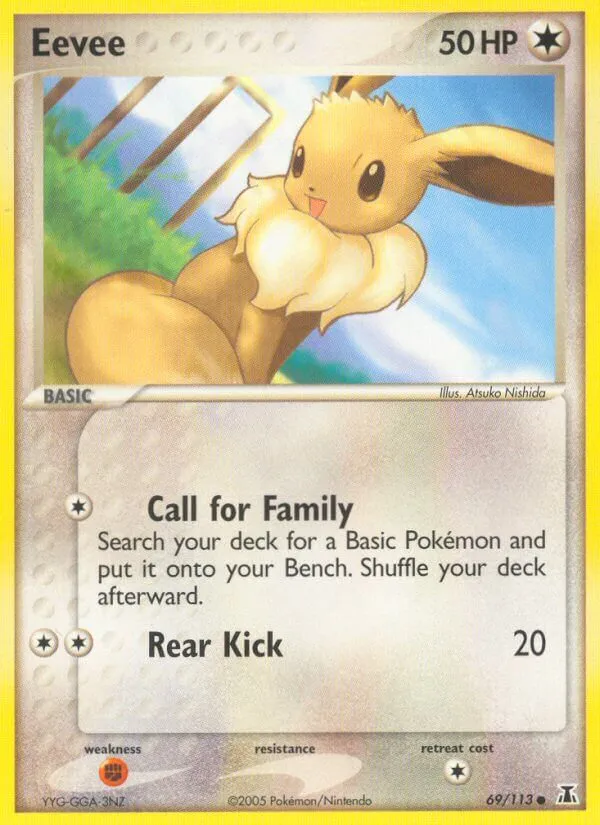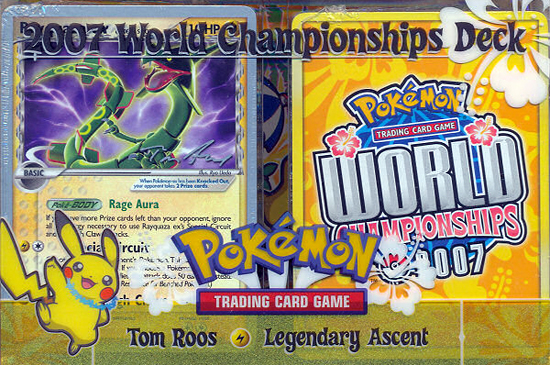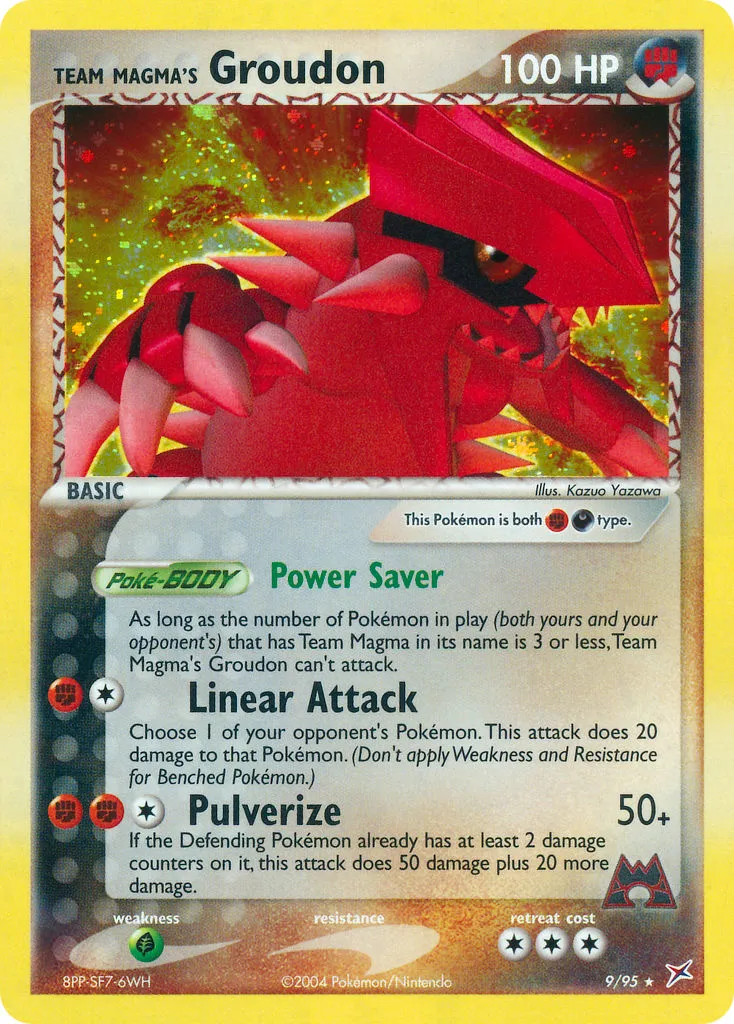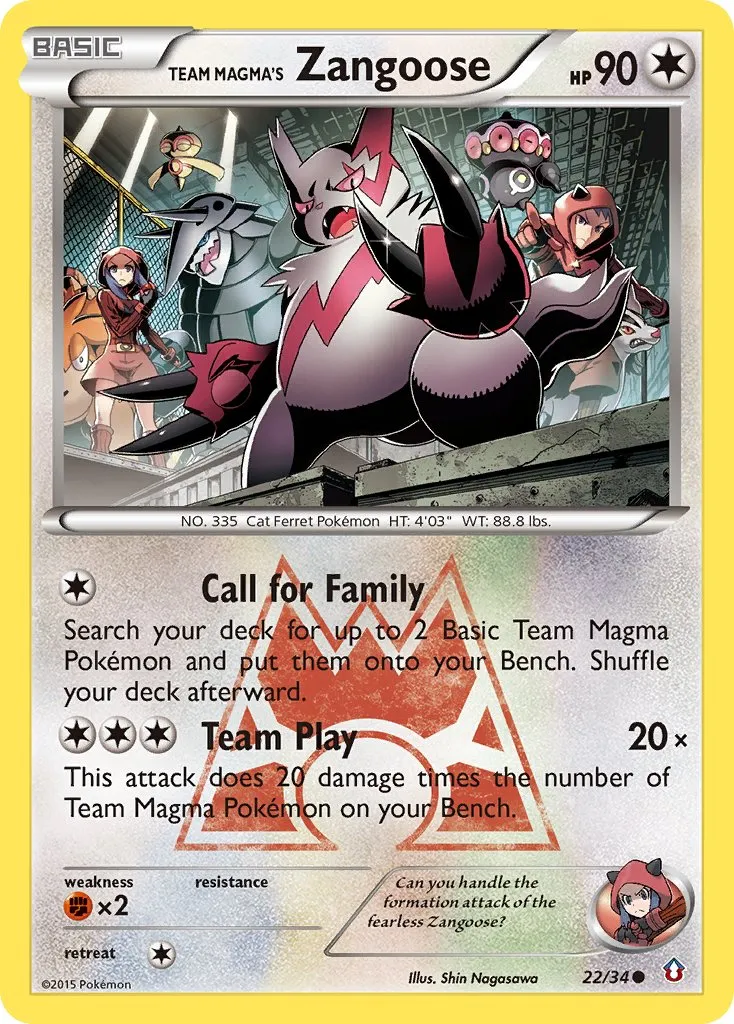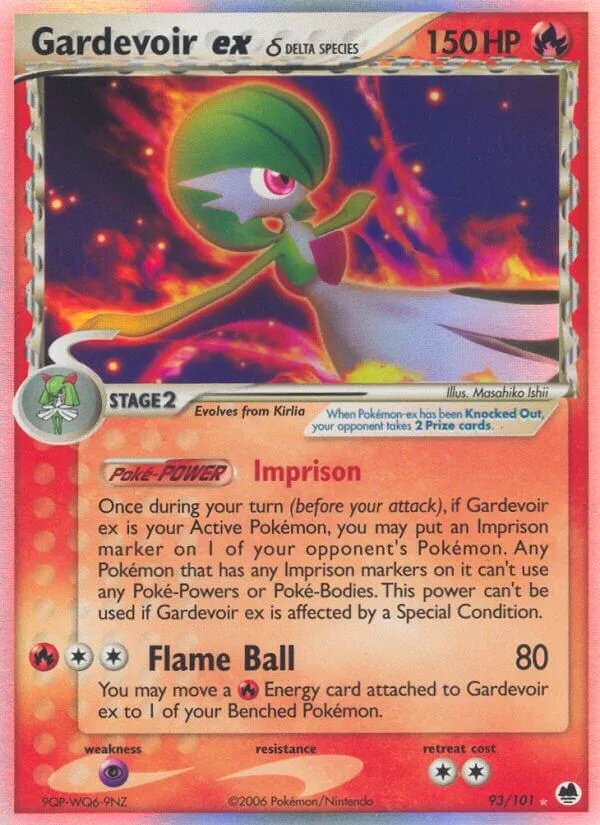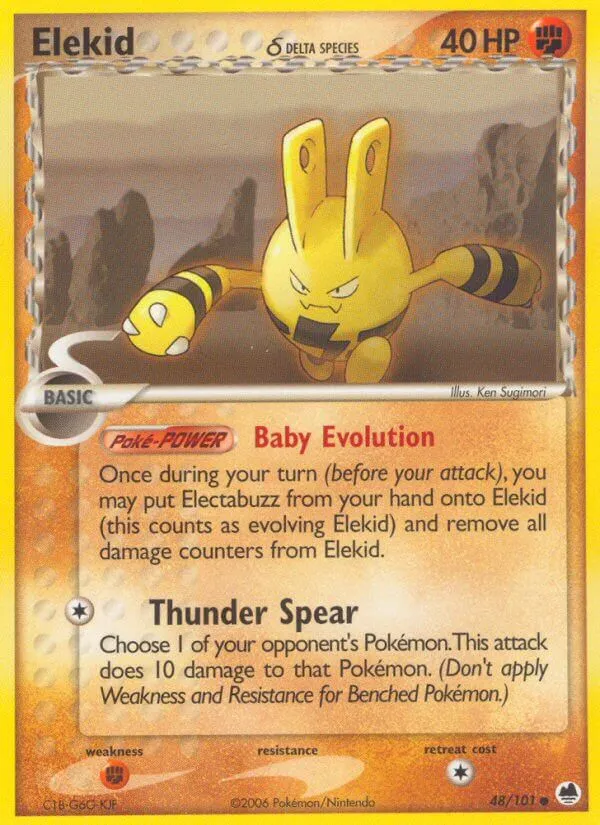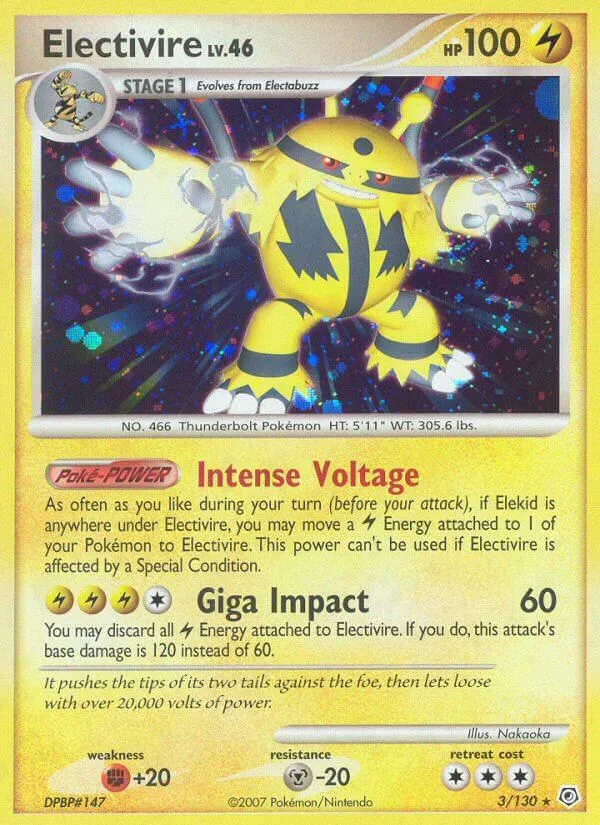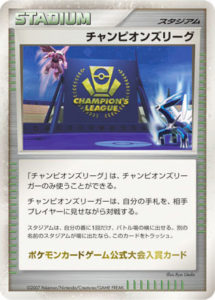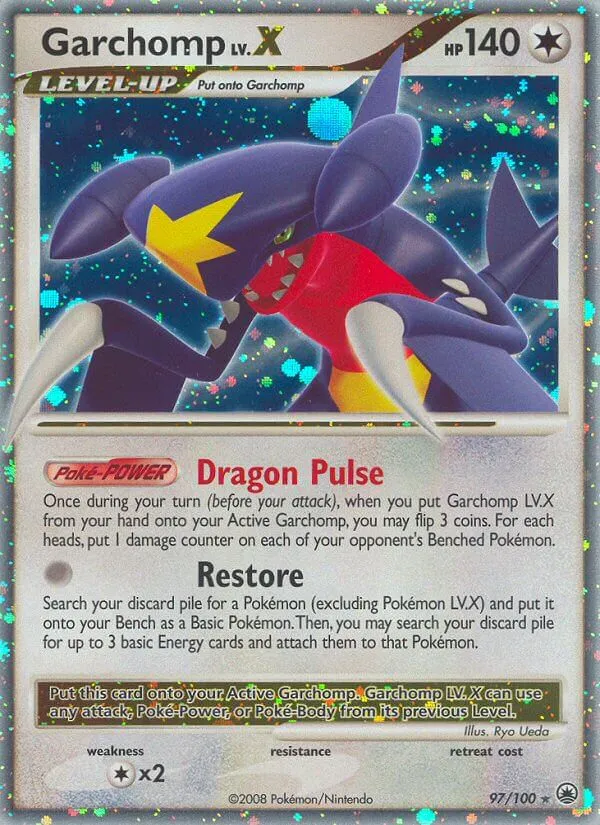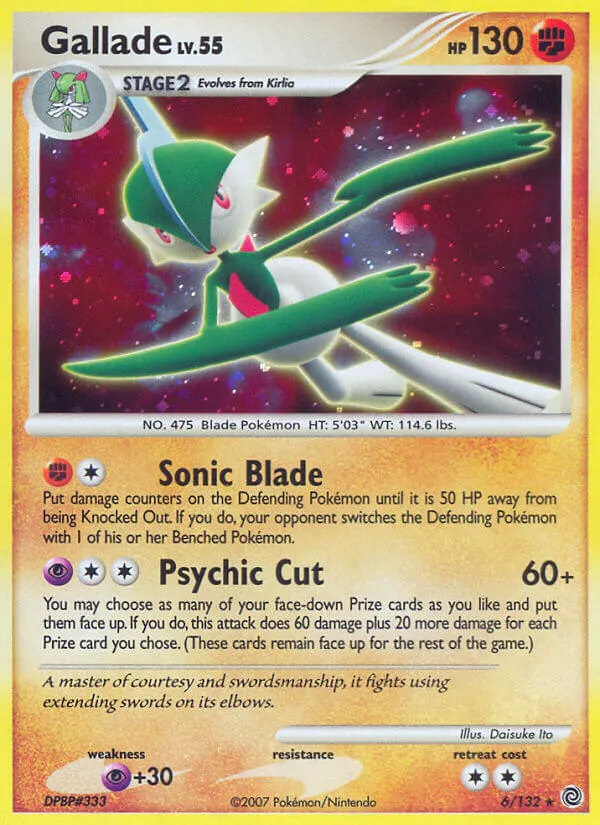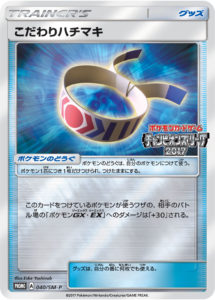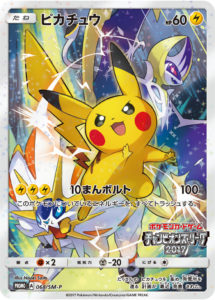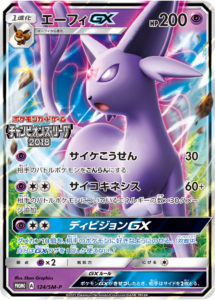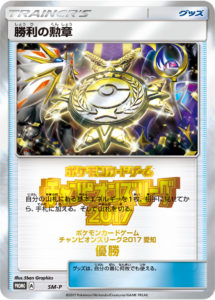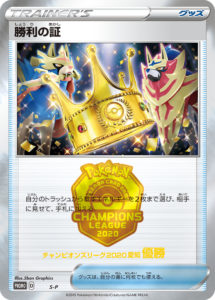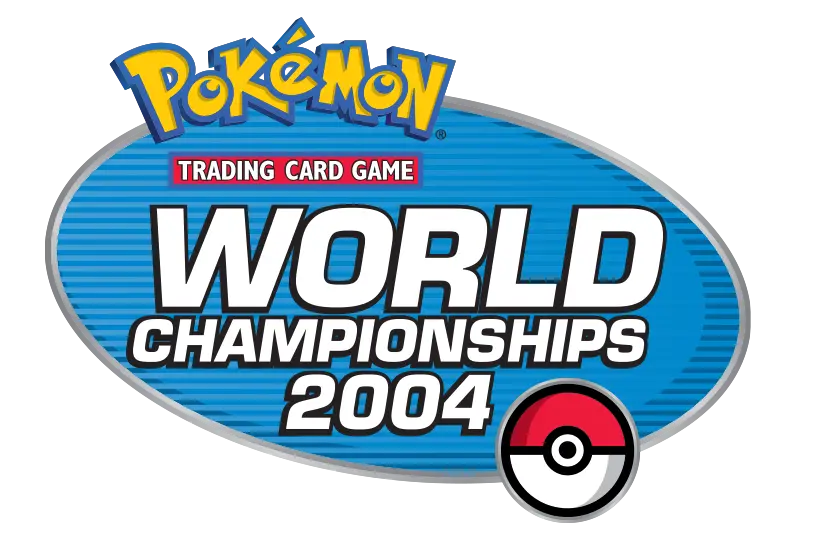The original Champion’s League tournaments were the penultimate competitive TCG championships from 2000 until 2008. They were exclusive invitation-only tournaments that represented the pinnacle of Pokemon TCG competitive play.
Beginning at the end of Champion Road 2000, the Champion League tournament would invite champions from past major official tournaments to compete amongst each other and crown an overall champion across multiple tournament circuits.
Long after the final Champion’s League had concluded, the tournament name was reused for Japan’s national championship circuit starting in 2016. These modern Champion’s league events were not invitation-only, and were open all Japanese players.
1st Champion’s League
The inaugural Champion’s League was held a day after the Best in Japan match for Champion Road 2000. It was held at an Official Tokyo Pokemon Gym on February 27, 2000.
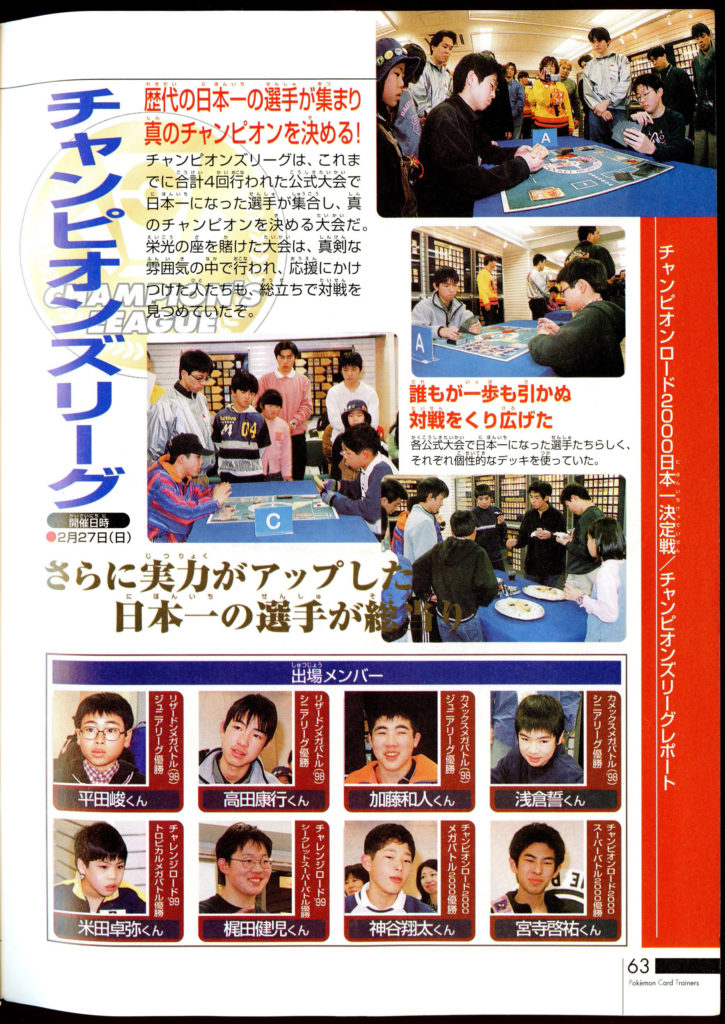
Participants
The event invited the junior and senior league national champions of each of the 4 previous official tournament circuits. This meant there were 8 total participants.
Juniors participants
- Shun Hirata – 1998 Lizardon Mega Battle Junior Champion
- Kazuto Kato – 1998 Kamex Mega Battle Junior Champion
- Takuya Yoneda – 1999 Challenge Road Tropical Mega Battle Champion
- Shota Kamiya – 2000 Champion Road Mega Battle Champion
Seniors participants
- Yasuyuki Takata – 1998 Lizardon Mega Battle Senior Champion
- Sei Asakura – 1998 Kamex Mega Battle Senior Champion
- Kenji Kajita – 1999 Challenge Road Secret Super Battle Champion
- Keisuke Miyadera – 2000 Champion Road Super Battle Champion
Tournament
The 8 participants played a round-robin qualifying tournament amongst each other, meaning that players got points for wins and draws. After the qualifying tournament was concluded, the two players with the highest total point totals would face each other in the finals.
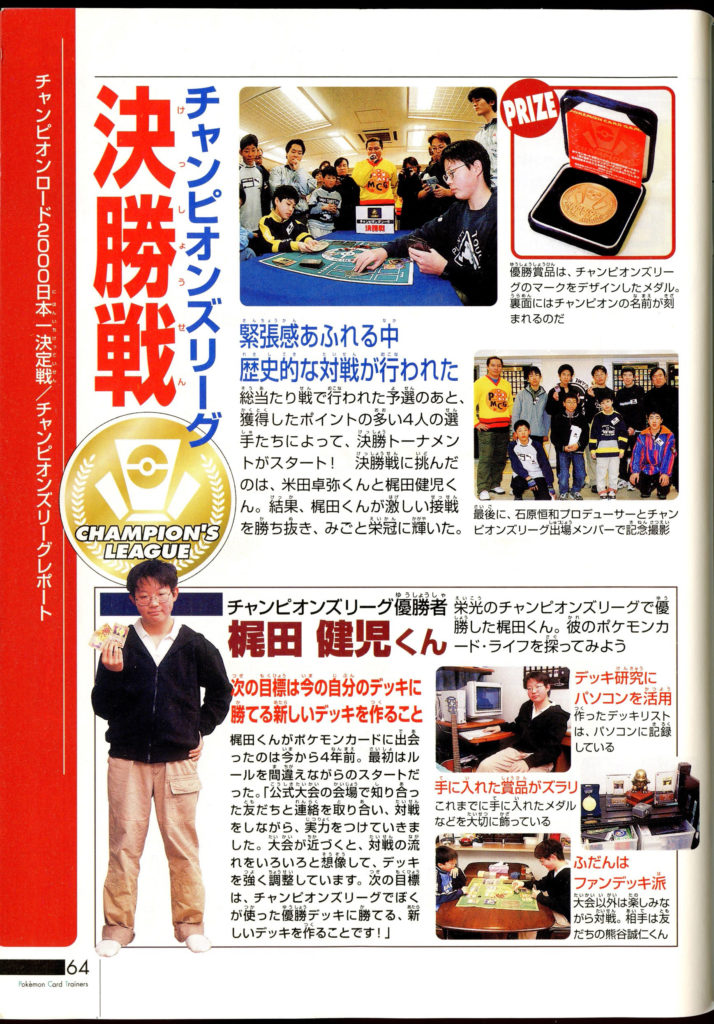
For the 1st Champion’s League, the finalists were junior league competitor Takuya Yoneda and senior league competitor Kenji Kajita. Kajita ended up winning the competition, becoming the first ever “true champion” of the Pokemon TCG.
Winners of the early Champion’s Leagues would receive a special medal with the event symbol on it. Engraved on the back would be the winner’s name.
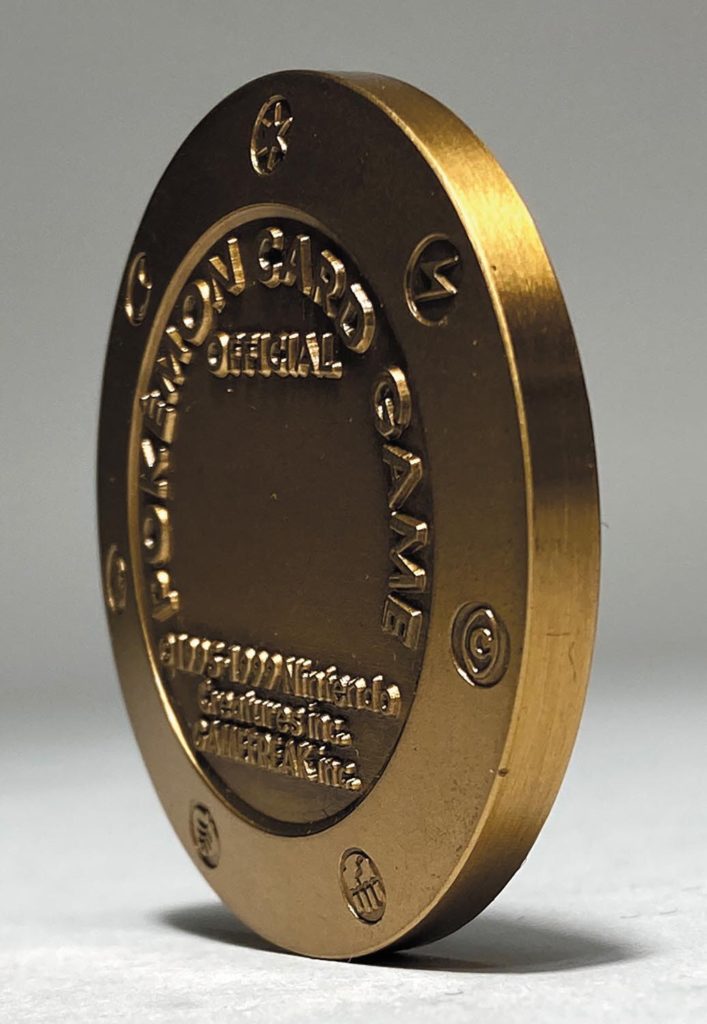
The medal was presented in a custom-designed flecked case.
2nd Champion’s League
The 2nd Champion’s League was held after the events of the 2000 World Challenge Summer on August 20, 2000 at the same venue as the 1st Champion’s League, the Official Tokyo Pokemon Gym.


Participants
The event invited back all 8 participants from the 1st Champion’s League and also added 3 new participants: the top 3 seniors division winners from the 2000 World Challenge Summer events. This would bring total number of participants to the 11 following players:
Juniors participants
- Shun Hirata – 1998 Lizardon Mega Battle Junior Champion
- Kazuto Kato – 1998 Kamex Mega Battle Junior Champion
- Takuya Yoneda – 1999 Challenge Road Tropical Mega Battle Champion
- Shota Kamiya – 2000 Champion Road Mega Battle Champion
Seniors participants
- Yasuyuki Takata – 1998 Lizardon Mega Battle Senior Champion
- Sei Asakura – 1998 Kamex Mega Battle Senior Champion
- Kenji Kajita – 1999 Challenge Road Secret Super Battle Champion
- Keisuke Miyadera – 2000 Champion Road Super Battle Champion
- Yoshiko Harada – 2000 World Challenge Summer Secret Super Battle Champion
- Toshiyuki Yamaguchi – 2000 World Challenge Summer Secret Super Battle 2nd place
- Yasuhiro Murakami – 2000 World Challenge Summer Secret Super Battle 3rd place
Tournament
In addition, the 2nd Champion’s League would introduce a new rule that only the top 8 players would be eligible to remain in the Champion’s League.
The tournament was played as a round-robin tournament amongst all 11 players, and then likely the two players with the best records would play for the finals. In the end, Keisuke Miyadera, the 2000 Champion Road seniors champion would be crowned as the winner. He would win the same medal as the previous Champion’s League with his name engraved on the back.

Although full standings were not publicly published, based on the attendees of the 3rd Champion’s League, we can see that the following 3 players were eliminated from the Champion’s League:
- Shun Hirata – 1998 Lizardon Mega Battle Junior Champion
- Yasuyuki Takata – 1998 Lizardon Mega Battle Senior Champion
- Kenji Kajita – 1999 Challenge Road Secret Super Battle Champion
Notably, Kajita was the “true champion” of the 1st Champion’s League, but ended up in the bottom 3 of the 2nd Champion’s League and therefore dropped out of it.
3rd Champion’s League
The 3rd Champion’s League was held on April 1, 2001. It again invited back the 8 members of the previous Champion’s League and added 3 new participants.
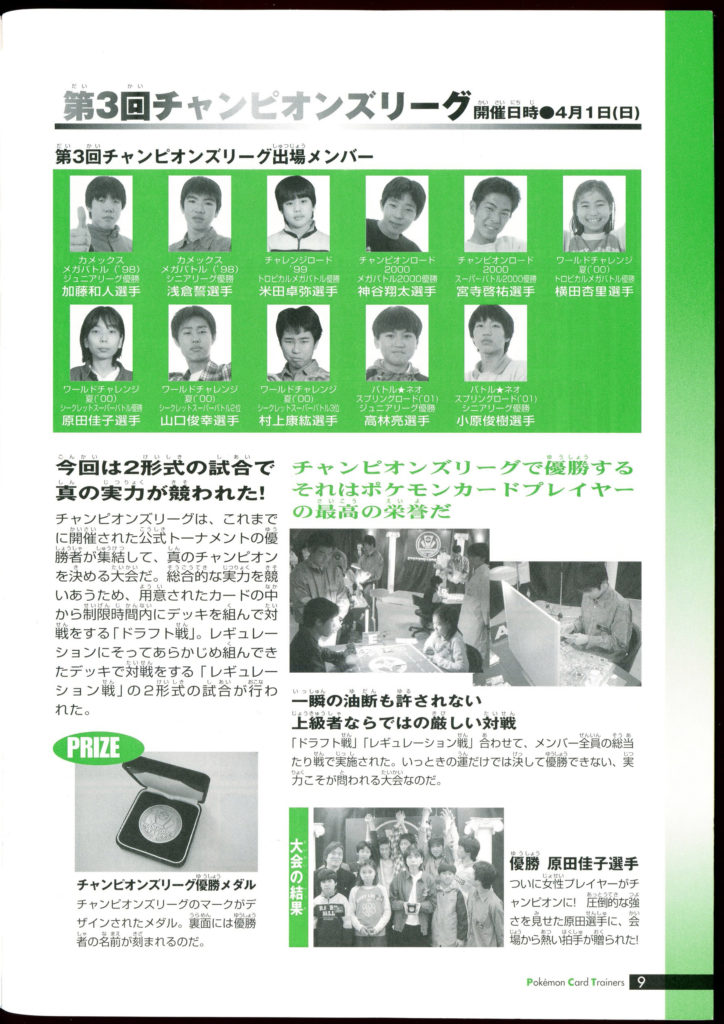
Participants
Two of the new participants were the junior and senior league winners of the 2001 Battle Neo Spring Road events. The third participant was actually a past winner who was not in the previous Champion’s League. Anri Yokota was the 2000 World Challenge Summer Tropical Mega Battle (Juniors) champion. In the 2nd Champion’s League only the top 3 winners of the seniors division were invited, so Yokota was likely invited to increase the number of juniors slightly. This brought the total list of attendees to:
Juniors participants
- Kazuto Kato – 1998 Kamex Mega Battle Junior Champion
- Takuya Yoneda – 1999 Challenge Road Tropical Mega Battle Champion
- Shota Kamiya – 2000 Champion Road Mega Battle Champion
- Anri Yokota – 2000 World Challenge Summer Tropical Mega Battle Champion
Seniors participants
- Sei Asakura – 1998 Kamex Mega Battle Senior Champion
- Keisuke Miyadera – 2000 Champion Road Super Battle Champion
- Yoshiko Harada – 2000 World Challenge Summer Secret Super Battle Champion
- Toshiyuki Yamaguchi – 2000 World Challenge Summer Secret Super Battle 2nd place
- Yasuhiro Murakami – 2000 World Challenge Summer Secret Super Battle 3rd place
- Ryo Takabayashi – 2001 Battle Neo Spring Road Junior League Champion
- Toshiki Obara – 2001 Battle Neo Spring Road Senior League Champion
Tournament
For the 3rd Champion’s League, competitors had to play in 2 kinds of battles. The first kind, “Draft Battles”, were played by building decks from a present group of cards within the time limit. The second kind of battle, “Regulation Battle”, were more standard where players used decks they had built according to regulations to play against each other.

Players played in a round-robin tournament similar to past Champion’s Leagues, and at the end the top 2 players with the most points faced each other in the finals.
Yoshiko Harada (the 2000 World Challenge Summer Secret Super Battle Champion) ended up being the overall champion, and became the first-ever female champion of the Champion’s league. She received a medal engraved with her name similar to previous events.
4th Champion’s League
Very little information is available on the 4th Champion’s League as the Trainers Magazine did not publish a report on it, and no online reports are available. All that is known about it is that it was held in September 2001 after the events of the 2001 Battle Neo Summer Road.
5th Champion’s League
The 5th Champion’s League was held on August 18, 2002 at the Tokyo Industrial Trade Center in Hamamatsucho, Tokyo.. This was a day after Battle Road 2002’s Best in Japan Battle on August 17, 2002 at the same venue.
Participants
A total of 16 players participated in this Champion’s League. 8 of them were returning Champion’s League players from the 4th Champion’s league, and another 8 were the top 4 junior league and senior league winners from Battle Road 2002.
Tournament
Competitors brought a 30-card half deck that they had prepared in advance, and then were given 10 packs of the Split Earth set (released as part of Skyridge internationally) to make another 30-card deck at the event. It is unknown if players played games with these half-decks or had to combine both together to make a single 60-card deck.
The two finalists were Toshiki Obara, the 2001 Battle Neo Spring Road Senior League champion, and Takuto Nakai, the Battle Road 2002 senior league champion. In the end, Obara was crowned the champion.
Champion’s League 2003
Starting with this event, Champion’s League tournaments would stop being referred to with numbers and instead be aligned to years.
Participants
Champion’s League 2003 was held on August 30, 2003 at the Naeba Prince Hotel in the Niigata prefecture. Starting with this year’s Champion’s League, previous winners of past official tournaments were no longer invited. Instead, the winners of each age division from Battle Road Summer 2003‘s regional tournament circuit were invited to attend. This meant that the Champion’s League 2003 would replace 2003’s traditional “Best in Japan” match used to determine a national champion.
Since there were 9 regional Battle Road Summer 2003 tournaments, and each age division had 3 winners, this mean that there were 27 participants in each age group, for a total of 81 participants.
Tournament
The tournament format used 60-card decks in a “Double Battle” format. In this format, each player puts out two active Pokemon instead of the normal one. Players could only have up to 4 benched Pokemon instead of 5. Only one Pokemon could attack each turn despite there being two active Pokemon. Players would have to select a specific active Pokemon on the opponent’s side to attack.
After 8 rounds of matches, the winners were determined. The top 4 winners in each age division were given the title of “Elite 4” (similar to the video games), while the champion of each age division was given a special title. For the junior and senior league champion, they were deemed the “Junior Grand Champion” and “Senior Grand Champion” respectively. The masters league champion was crowned the “Grand Master”. All 3 of these champions were invited to participate in the next year’s Champion’s League.
Champion’s League 2004
There is no documentation available online or in print media about this event. It was probably held for the winners of Battle Road Summer 2004, but no records of it exist.
Champion’s League 2005
Champion’s League 2005 was held on September 18, 2005 from 9:00 to 17:00 at TFT Hall in Tokyo, Japan. The event for the first time also featured side events that spectators could play at.
Participants
The event invited the 1st place winners of the junior, senior, and masters leagues from Battle Road Summer 2005, as well as the “Elite 4” of the 2004 tournament circuit to decide the true national champion.
Only the surnames of each winner are known, but it’s fairly straightforward to calculate the total number of participants for this event. For Battle Road 2005, there were 9 regional tournaments per age division, this means that there are 9 champions per age division from Battle Road 2005. Adding in the 4 “Elite 4” members from the previous year ends up with a total of 13 participants per age division. With 3 age divisions across junior, senior, and masters leagues, a total of 39 players would compete in this event.
| Regional Tournament | Junior | Senior | Master |
|---|---|---|---|
| Hokkaido | Takaoka | Fujimori | Izumi |
| Tohoku | Yoneda | Moriya | Yamato |
| Kanto A | Shiraishi | Saito | Sugano |
| Kanto B | Takahashi | Kobayashi | Saito |
| Chubu | Daimon | Nakai | Kadowaki |
| Kansai A | Hasegawa | Yumioka | Furukawa |
| Kansai B | Hiraiwa | Kataoka | Saito |
| Chugoku | Horie | Ishimitsu | Asai |
| Kyushu | Takahashi | Yukihiro | Soejima |
Tournament
Champion’s League 2005 was split into a qualifying round and a final tournament. During the qualifying round, players competed in a Swiss-draw style tournament, and the top 4 players in each age division would advance to the final tournament.
Those who made it to the final tournament were crowned as the “Elite 4” within each of their age divisions. They would then compete amongst each other to determine a grand champion, as well as 2nd – 4th place.
| Juniors Elite 4 | Seniors Elite 4 | Masters Elite 4 | |
|---|---|---|---|
| Grand Champion | Okubo | Kataoka | Sugano |
| 2nd Place | Yoneda | Yukihiro | Yanagi |
| 3rd Place | Miyazaki | Nakai | Asai |
| 4th Place | Sato | Miyamoto | Saito |
The grand champion of each age division received multiple prizes, including a full set of the currently available Pokemon gold star cards, a playmat with the Champion’s League logo, and most notably an exclusive trophy card. This card was presented in a trophy shield.
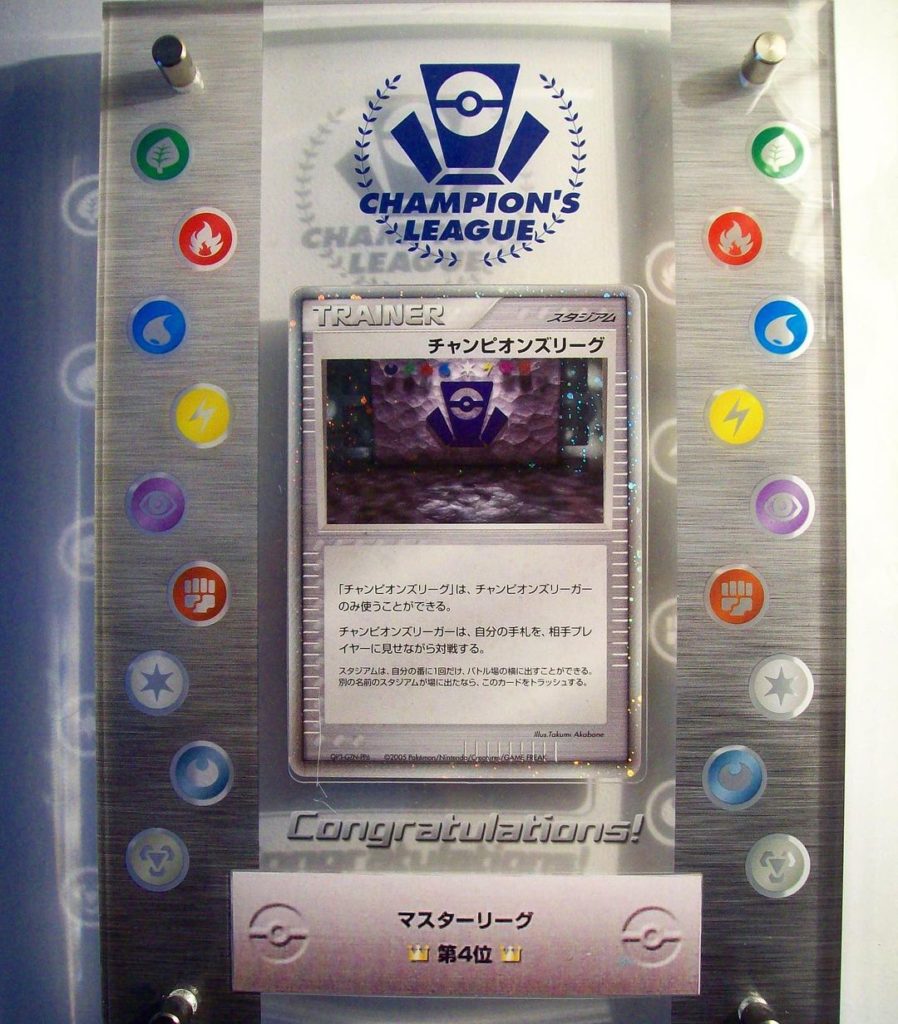
Side events
There were also side events where attendees could play at the venue. The first side event was a free battle area, where players would enjoy playing the game and trading.
The second side event was a “Challenge PCL” event. This had been previously held at Battle Road 2004. Pokemon Card Laboratory (PCL) “researchers” were available at this corner to challenge trainers to battle. PCL is the Pokemon TCG’s development team for the game, so the decks they used were all finely tuned. Defeating a PCL researcher would win you a special promo card.
Champion’s League 2006
Champion’s League 2006 was held on September 17, 2006 for the first time in a location outside of Japan. The tournament was held at the Taiwan PokePark, which was open from June 23, 2006 to September 24, 2006.
During the last week the the Taiwan PokePark was open, special promo cards were distributed each day to attendees, with audience members of the 2006 Champion’s League receiving an exclusive Chinese Championship Arena.
This card was given only to those who watched the tournament. It is therefore quite rare, as most attendees of the park were there to go on rides and other attractions.
Participants
The previous “Elite 4” of each age division from Champion’s League 2005 were invited, as well as all the 1st place champions of Battle Road Summer 2006‘s regional tournaments. This meant that there were 12 returning winners, and 27 new champions in attendance for a total of 39 participants.
Tournament
Champion’s League 2006 was split into a morning and afternoon session. In both sessions, players would play games with 60-card deck throughout 4 rounds of Swiss-draw tournaments. The results for both the morning and afternoon sessions would be totaled for each age division, and the top 4 players would be crowned as the new “Elite 4”. The two sessions each had different deckbuilding regulations
Morning session
The morning session was played in the “A Deck Regulation” format. This meant that only cards from the most recent sets were available to use, and can be likened to the modern-day “Standard” format. Promo cards were not allowed to be used.
Preconstructed decks:
- Holon’s Research Tower Half decks
- Groudon ex & Kyogre ex starter decks
- 60-card Gardevoir ex & Tyranitar ex preconstructed decks
Expansions:
- Holon’s Research Tower (released as EX Delta Species overseas)
- Holon’s Shadow (released as EX Holon Phantoms overseas)
- Miracle Crystal (released as EX Crystal Guardians overseas)
- Final Battle (released as EX Dragon Frontiers overseas)
Many of the decks that were popular during Battle Road 2006 and the 2006 World Championships had rotated out, so the morning session decks were more similar to decks that would be played in the upcoming 2007 competitive play season.
In particular, a deck featuring Rayquaza, Lickitung, and Eeveelutions would win both the Senior and Masters Leagues.
This deck archetype would later go on to win the 2007 World Championships, and would be named “Legendary Ascent”. Tom Roos piloted the deck to win the Masters division championship.
Afternoon Session
The afternoon session was played with the “B Deck regulation” format. This format allowed all cards printed from the first ADV set (released as EX Ruby Sapphire overseas) all the way to the most recently printed cards. This was the same format that Battle Road Summer 2006 was played with, and allowed for some interesting deck archetypes that never made it to the international scene.
In the junior age division, the 1st – 3rd place winners all used the same deck featuring Team Magma’s Groudon along with Cessation Crystal. These two cards were never legal in the same standard format overseas, but formed a strong part of the Japanese metagame. Cessation Crystal shut down both opposing Poke-Powers / Bodies, but also could disable Groudon’s Poke-Body, which was a downside. The deck also utilized cards like Team Magma’s Zangoose for support.
In the seniors league, decks utilizing Banette ex and Sableye were prevalent. The aggressive deck utilized Banette ex’s Shadow Chant move to deal quick damage while discarding supporter cards with Sableye’s Excavate Poke-Power.
This deck archetype would eventually go on to be piloted by Jeremy Scharff-Kim to fittingly become the Senior Division Champion in the 2007 World Championships. Known as “Rambolt”, this deck would replace Sableye with Solrock and Lunatone cards as secondary attackers.

In the Masters league, players utilized decks with Gardevoir δ species ex, Scizor ex, and Pidgeot. This deck utilized powerful Pokemon ex to disrupt the opponent while attacking for big damage. Pidgeot was one of the most prevalent cards in the metagame, with a Poke-Power to search for any card. Gardevoir was able to shut down opposing deck’s Pidgeots while effectively using its own.
After the morning and afternoon sessions, the final standings were as follows:
| Juniors Elite 4 | Seniors Elite 4 | Masters Elite 4 | |
|---|---|---|---|
| Grand Champion | Doi (female winner!) | Miyamoto | Kadowaki |
| 2nd Place | Nakai | Kondo | Yanadi |
| 3rd Place | Nakamura | Yukihiro | Sugano |
| 4th Place | Otsuka | Tamura | Asai |
The top 4 winners of each age division would again be rewarded with a Champion’s League promo card, identical to the one previously awarded in 2005. However, the trophy shield case it was awarded in changed in 2006.
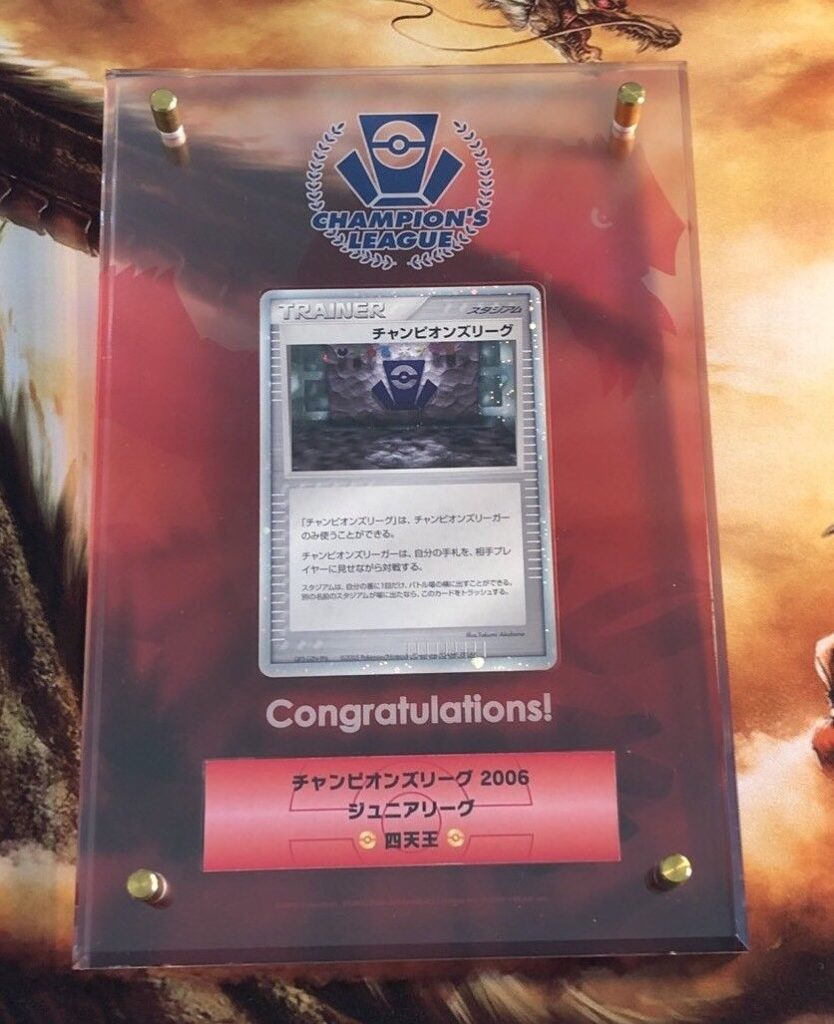
Teaching Corner
The Champion’s League in Taiwan also featured side events where attendees could play in free matches and learn how to play the game. The teaching corner rewarded players with a Chinese version of the Pokemon Fan Club card previously distributed as a promo in Japan.
Champion’s League Spring 2007
2007 was the final year that the Champion’s League was held, as the event would be replaced with the Japan National Championships events. Unlike previous years, both a spring and summer tournament were held.
Champion’s league Spring 2007 was held on May 13, 2007 at an unspecified venue in Tokyo, Japan.
Participants
Unlike the Champion’s League 2006, the 2007 events did not invite back the previous year’s “Elite 4”. Instead, only the regional champions in each age division of Battle Road Spring 2007 were invited. Since 9 regional tournaments were held with 3 age divisions, this mean that there were a total of 27 participants in this event.
Tournament
Similar to the previous year, the event was divided into a morning session and afternoon session. Each of the sessions had different deckbuilding rules, and both the sessions were played with full 60-card decks and 6 prizes in the Swiss draw tournament structure. Players played 4 games in each session, with each game having a 30 minute time limit.
Morning Session
Reversed from the 2006 event, the morning section was played with the “B Deck regulation” format where all new back printed cards and promos were legal to use. This spanned from the first ADV set (EX Ruby Sapphire overseas) all the way to the most recent DP2 set (Mysterious Treasures overseas). This was the same format used Battle Road Spring 2007.
Players utilized many championship-winning decks in this expanded format. Team Magma’s Groudon made a repeat appearance from Champion’s League 2006, alongside other cards like Dark Tyranitar (which was part of the 2005 World Championships winner’s deck), Exeggutor δ species, and Blissey.
Afternoon session
The afternoon session used the deckbuilding regulations of the 2007 World Championships, also known as “A Deck regulation”. Only cards from the most recently-released sets were legal to use.
A deck archetype utilizing Exeggutor δ species and Raichu δ species was played during this session. This deck would later be dubbed “Raieggs”, and was widely used due to its ability to spread damage around quickly with Exeggutor δ’s Split Bomb attack and shut down other decks by dealing good damage to any Pokémon with a Poké-Power / Bodies. It also utilized Cessation Crystal to great effect since it ran no Pokemon of its own with Poké-Powers / Bodies.
Additionally, decks featuring the Electivire evolution line. Elekid δ species and Electabuzz δ species offered quick set up, and Electivire dealt heavy damage every turn.
After both sessions had concluded, scores were totaled from both sessions to determine the “Elite 4” for each age division.
| Juniors Elite 4 | Seniors Elite 4 | Masters Elite 4 | |
|---|---|---|---|
| Grand Champion | Hasegawa (female winner!) | Miyazaki | Yamato |
| 2nd Place | Seki | Akimura | Nakahama |
| 3rd Place | Otsuka | Hasegawa | Ohno |
| 4th Place | Inoue | Takusa | Tawa |
Each of the Elite 4 winners received a Champion’s League promo card in a trophy shield. This card featured new artwork with the Diamond and Pearl legendaries, Palkia and Dialga.
Champion’s League Summer 2007
The final iteration of the original Champion’s League was held on September 9, 2007 after the events of Battle Road Summer 2007. It would be replaced with the Japan National Championships events in 2008 and onwards.
Participants
Only the regional winners of each Battle Road Summer 2007 tournaments were invited, and previous winners weren’t included. With 8 regional tournaments and 3 age divisions, this means that a total of 24 players participated in the event.
Tournament
Unlike the Champion’s League Spring 2007 tournament, this tournament only had a single session. Each player would have to play in a round robin against the 7 other players in their age division once, then the players would be ranked based on their overall records.
Players were restricted to using cards from the DP-era expansions, and played matches with full 60-card decks and 6 prize cards. Cards like Garchomp Lv.X, Blissey, and Gallade saw play across all age divisions.
After all games had been played, the top 4 players in each league were crowned as the new “Elite 4”. They would receive Champion’s League playmat with the event logo in foil, 180 white card sleeves with the Champion’s League logo, and the a trophy plaque with the updated Champion’s league promo card.
| Juniors Elite 4 | Seniors Elite 4 | Masters Elite 4 | |
|---|---|---|---|
| Grand Champion | Yano | Suzuki | Sugano |
| 2nd Place | Hasegawa | Tosa | Yamato |
| 3rd Place | Yamaguchi | Suzuki | Mizuto |
| 4th Place | Muto | Naito | Shiraishi |
The grand champion of each age division received an invite to next year’s 2008 World Championships.
Legacy
The Champion’s League tournaments would be would be succeeded by the Japan National Championships events in 2008 and onwards. While they originally were meant as more of a penultimate tournament after all the regional tournaments had concluded, they eventually morphed over time into national championship tournaments.
This caused them to be redundant, since they were far more exclusive than the open nature of the 2008 Japan World Championship Representative Tournament and still served the same goal of determining the best players in Japan to send to the World Championships.
In 2016, the Pokemon TCG would start a new tournament series also named the Champion’s League, but they were essentially the same as the regional tournament circuit and thus open to all players. These tournaments rewarded various participation and prize promos.
These tournaments would reward trophy cards to top-finishing players in each region as well, but didn’t determine a national champion.
Sources
- Trainers Magazine Vol 6, pg. 63-64
- Trainers Magazine Vol 8, pg. 10-11
- Trainers Magazine Vol 11, pg. 9
- https://web.archive.org/web/20050901173926/http://www.pokemon-card.com/event/index.html
- https://k.mandarake.co.jp/auction/item/itemInfoJa.html?index=658433
- http://web.archive.org/web/20090228082857/http://www.pokemon-card.com/event/report/020818.html
- https://seesaawiki.jp/w/jester_the_pcg/d/%A5%C0%A5%D6%A5%EB%A5%D0%A5%C8%A5%EB
- http://web.archive.org/web/20090228082917/http://www.pokemon-card.com/event/report/030901.html
- http://web.archive.org/web/20090228083054/http://www.pokemon-card.com/event/report/050918.html
- http://web.archive.org/web/20090228083208/http://www.pokemon-card.com/event/report/060917.html
- http://web.archive.org/web/20090207043500/http://www.pokemon-card.com/event/report/070513.html
- http://web.archive.org/web/20081205040531/http://www.pokemon-card.com/event/report/070914.html




